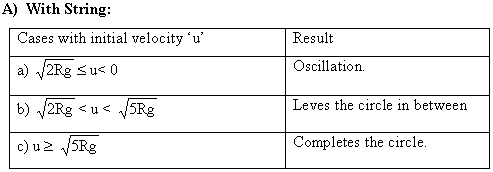Work Power Energy -4
CIRCULAR MOTION:
Uniform Circular motion: Angular velocity w is constant throughout the motion. The magnitude of velocity also remains constant.
Non-Uniform Circular motion: Angular velocity ‘![]() ’ changes with time.
’ changes with time.
Relation Between v,![]() , r,
, r,![]() :
: ![]()
Taking a small time interval ![]() t in which body
t in which body
moves an angle ![]()
![]() (very small)
(very small)
 Fig (19)
Fig (19)Considering this time interval to be so small that the distance is almost straight line.


Actual vector equation:
CENTRIPETAL AND TANGENTIAL FORCES:
The forces acting on a body could be resolved into two components, one in radial direction and one in tangential direction.
The force in radial direction is called CENTRIPETAL FORCE and the other is called TANGENTIAL FORCE.

Fig (20)
In equation
First part is tangential acceleration and second is centripetal acceleration.
Illustration:
A 0.1 Kg block is undergoing circular motion. What is the range of ‘
Solution:

Fig (22)
f.b.d of body for wmin, the particle will have tendency to move downwards.
For vertical Equilibrium of body
For body to rotate in circle, net force towards center of circle must be equal to m
![]()
From (1) and (2)![]() Now R = h tan450=h
Now R = h tan450=h 
For maximum value ‘![]() ’ the body will have tendency to move upwards
’ the body will have tendency to move upwards![]() Direction of friction will be in downward direction.
Direction of friction will be in downward direction.
Similar analysis yields.


